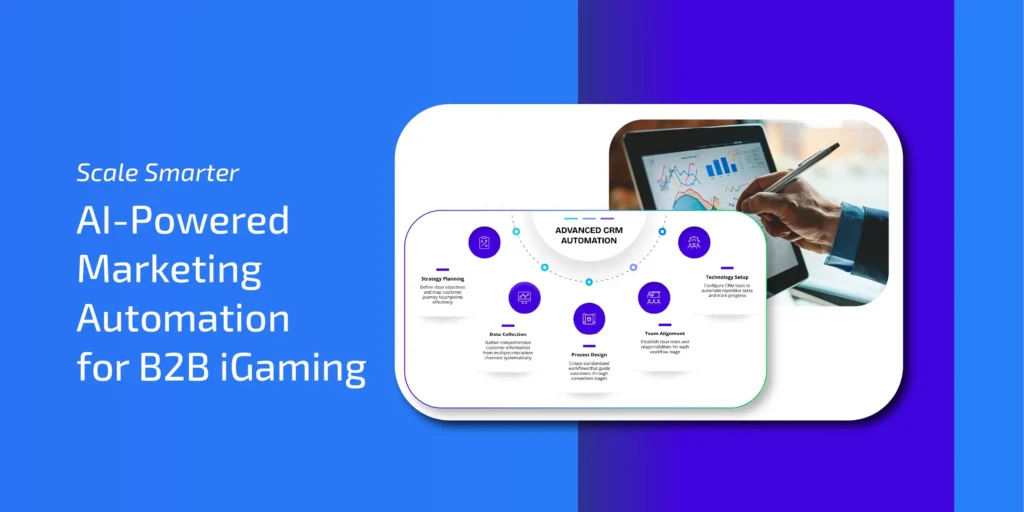B2B iGaming marketing teams are stuck in a high-speed hamster wheel. They’re moving fast but getting nowhere.
Brands are churning out more content, launching more campaigns and racing against the clock.
But without the right AI-powered automations, outdated tools and disconnected workflows slow everything down.
No matter how hard they hustle, nothing seems to move the needle.
Is your iGaming team also feeling the pressure to scale marketing without the right AI automation behind it? It’s time to fix the system before it stalls your growth.
What’s Breaking Even the Best B2B iGaming Marketing Teams
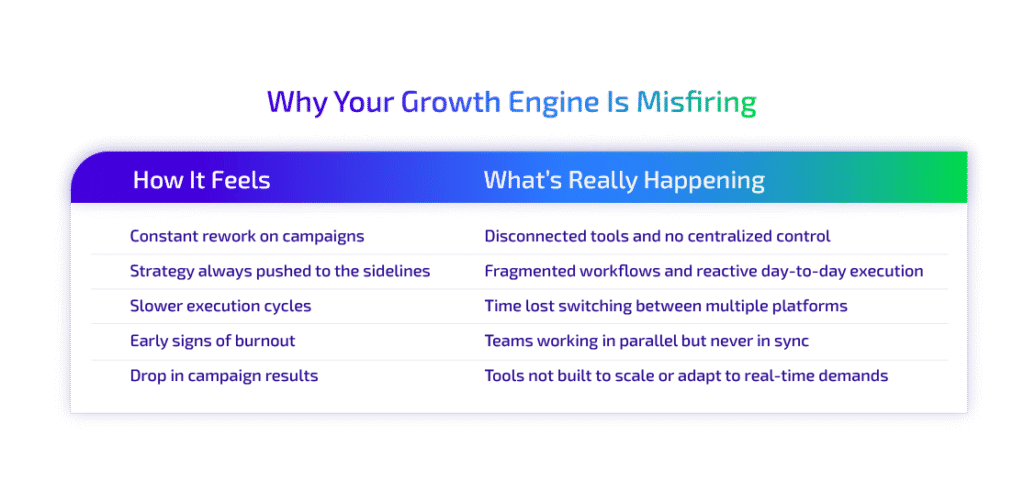
The B2B iGaming industry is firing on all cylinders. But behind the scenes, marketing teams are grinding their gears.
They’re pushing harder to deliver more with fewer hands and tools that no longer fit the job. What once felt fast and dynamic now feels clogged and reactive.
Growth targets keep rising, but headcount doesn’t. It’s like asking a car to go faster with a failing engine.
Tech stacks are bloated with tools that don’t talk to each other. Processes that worked at a smaller scale now need constant rework, slowing everything down.
If you feel like you’re spending more time keeping things aligned than actually making progress, you’re not alone. That’s the reality for many teams juggling endless fixes and messy workflows.
Without a centralized foundation, execution slows and chaos builds. The longer you ignore it, the harder it gets to get things back on track.
Pressure to Scale Without Increasing Headcount
Are you running a race that’s moving faster than you can keep up?
Lately, marketing teams in the B2B iGaming industry have been feeling the squeeze. Teams are still relying on outdated manual processes for campaign delivery, content creation and reporting.
The bar keeps moving higher. More campaigns to run, more personalization to deliver and less time to do it all. But teams are stuck trying to race with a flat tire. The focus should shift on building smarter systems that are built to keep up.
So, how do you meet those growing expectations? It starts with automation and streamlining processes that grow with you.
Disconnected Operations Lead to Burnout
You can feel it when a team is close to burning out. The content’s going out, but the results don’t follow. Campaigns are live, but insights arrive too late to act. Testing turns into a checkbox routine. And when personalization happens, it’s often rushed and inconsistent. Most times, it doesn’t even land where it should.
The problem isn’t the effort. It’s the system.
When tools are siloed and workflows don’t connect, execution breaks. Campaigns drift off course, stakeholders lose clarity, and teams spend more time untangling chaos than creating momentum.
No matter how hard your team pushes, burnout will slow your growth.
What AI-Powered Automation Really Means (And What It Doesn’t)
Ever feel like you’ve automated, but nothing’s actually smoother? That’s probably because you’re polishing the hood while the engine underneath is still broken.

For iGaming Marketing Teams Who Want More
Practical tips, trends, strategies, and more.
AI-powered automation should create a centralized, intelligent system that aligns strategy with execution and not just add new apps to the workflow. From campaign planning to performance tracking, everything should operate as one continuous loop.
The goal is to eliminate repetitive, low-value tasks. When content creation, testing, segmentation, and reporting are handled by a smart system, marketers can focus on driving growth.
When done right, AI becomes the backbone of marketing ops. It reduces the lag between insight and action, giving teams space to think, adapt, and scale without burning out.
Using AI as a Strategic System
Ever felt like you’re just patching up problems instead of fixing them? That’s what many B2B iGaming marketing teams do with task-based automation. Real AI-powered automation connects your marketing functions, learns from data, and provides insights that drive smarter decisions.
Rather than juggling separate tools, AI brings everything together in one seamless system. It streamlines your marketing and gives you the freedom to focus on what really matters.
Take a game provider, for example. By integrating campaign management with analytics, they tracked customer behavior in real-time. AI adjusted the campaigns automatically, freeing up the team to focus on creative and strategic decisions.
Difference Between AI-Enhanced and AI-Led Automation
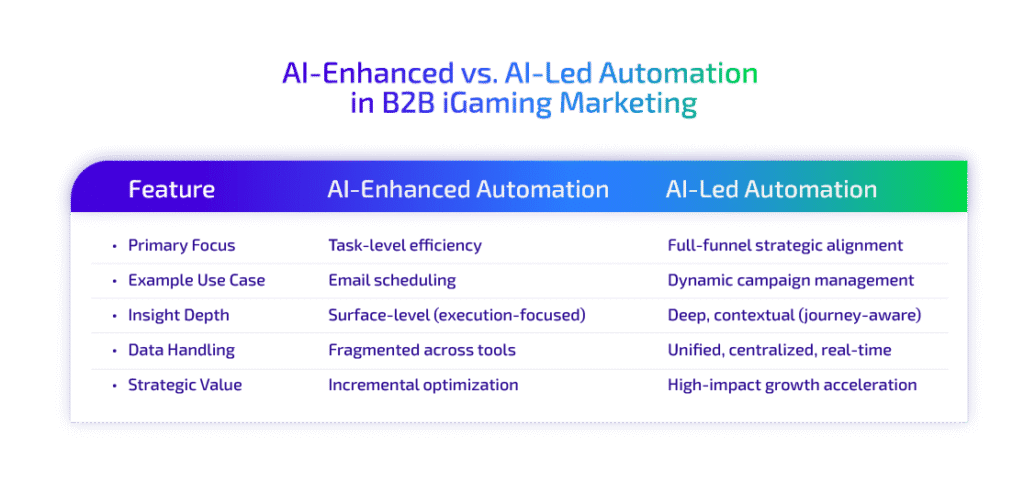
AI-enhanced automation is like adding a turbo boost to your existing processes. It handles repetitive tasks, like content scheduling and reporting, making things run smoother. But it’s limited. It’s still focused on individual tasks rather than driving your overall strategy.
On the other hand, AI-led automation is the game changer. It adapts your strategy in real-time, using data insights, customer behavior and market trends to guide decisions. This approach takes things to the next level, creating a system that not only works efficiently but also scales effectively.
Understanding the difference is essential for building a system that grows with your needs.
Cost of Getting Automation Wrong
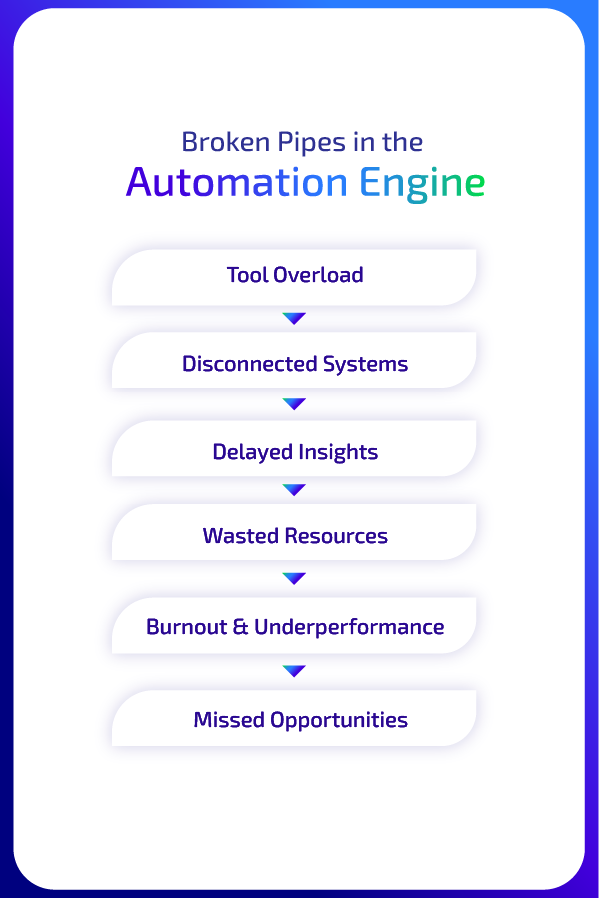
Do you ever feel like throwing resources at automation but not seeing the return? Jumping into automation without a solid strategy often leads to fragmented tools and wasted resources. Teams end up with disconnected systems that don’t communicate, resulting in poor execution and missed opportunities.
Without the right approach, automation becomes just another set of tools to manage, rather than a streamlined solution to improve efficiency.
So, how will it cost you? Wasted time, resources, and a growth potential that could have been used more effectively. When automation isn’t set up right, you’re missing out on the chance to scale smarter.
Pitfalls of Chasing Tools in Automation
Teams add ChatGPT for content, Canva for creatives, HubSpot for emails, Google Analytics for tracking, and some AI tools for testing. But nothing talks to each other. You end up switching between more tabs and not solving the core problem.
Let’s say a game provider launches a campaign. Content is built in one platform, emails go out from another, and performance data arrives in a different dashboard days later. By the time insights show up, the opportunities are already gone.
That’s the real pitfall. Brands keep stacking tools without building a system where automation flows smoothly from one platform to the next. Instead of fixing the process, they end up automating the chaos.
Shallow Data Leads to Shallow AI
Think of AI like a chef. If you only give it breadcrumbs, don’t expect a five-course meal. Most iGaming teams feed AI with fragmented inputs.
For example – isolated email open rates, poorly tagged CRM records and unsegmented audience lists. Without connected, enriched data, AI can’t see the bigger picture.
To unlock real value, your data needs to flow across touchpoints:
- CRM with clean, structured user profiles
- Campaign engagement metrics (opens, clicks, conversions)
- Game telemetry and behavioral event data
- Real-time operator feedback and partner channel performance
Real Example of Smarter AI Workflows
Here’s a real low-code workflow that cuts research and review time by up to 70% without taking control away from your writers.
This four-step setup uses Python, GPT‑4o, Notion, Google Docs, and Slack. Familiar tools make it easier to build systems your team already trusts.
Research, outline generation, and draft reviews are automated. Your team stays in control with fast approvals at each step.
No dev army or engineering rabbit holes. Just lightweight Python functions tied to tools like Google Custom Search API, Notion SDK, and Docs API. You can trigger it via command line, cron job, or even a Notion checkbox.
This is one of many ways AI can lighten your team’s load. From SEO audits to campaign QA, smarter systems exist for every bottleneck without overwhelming your budget or workflows.
But real automation needs more than scripts. It needs the right minds behind the machine. Whether you want no-code speed or low-code flexibility, we’ll help you build workflows that fit and perform.
- Generate Search Prompts from Topic Brief
- Notion SDK v2 reads your “New Topic” page (e.g. topic title, brief).
- GPT‑4o generates 3 focused search queries.
- Writer Checkpoint: Review/adjust queries in Notion before proceeding.
- Research Articles and Summarize Key Points
- Google Custom Search API runs each query and returns top URLs.
- newspaper3k scrapes and cleans article text.
- GPT‑4o ingests the raw texts and outputs a structured summary (headings, bullet‑point facts, citations) into a fresh Google Doc via docs.batchUpdate.
- Slack Notification: “Research summary ready: [Doc link]”
- Writer Checkpoint: Edit the summary in Docs and tick “Summary OK” in Notion.
- Build a Detailed Content Structure
- Upon the Notion approval, GPT‑4o produces a detailed outline (section headers + subpoints).
- The outline is appended to the same Google Doc.
- Slack Notification: “Outline complete: please review.”
- Writer Checkpoint: Refine headings and bullets, then mark “Outline OK” in Notion.
- Run an AI-Powered Draft Review
- The writer now writes the full draft in the Google Doc (or Notion, then transfers it). When they finish, they mark “Ready for Review” in Notion.
- When the writer flags “Ready for Review” in Notion, the script fetches the draft from Google Docs.
- GPT‑4o evaluates tone, SEO keyword usage, clarity, and fluff against your custom rubric.
- Parsed feedback is inserted as inline comments in the Doc using the Docs API’s createComment method.
- Slack Notification: “Review comments added - ready for final edits.”
Run It Your Way
- Manually: python pipeline.py via CLI.
- Automated: Schedule with cron, or use a Notion webhook/Zapier trigger to kick off each phase when its checkbox is toggled.
Introducing a Smarter AI-Powered Framework
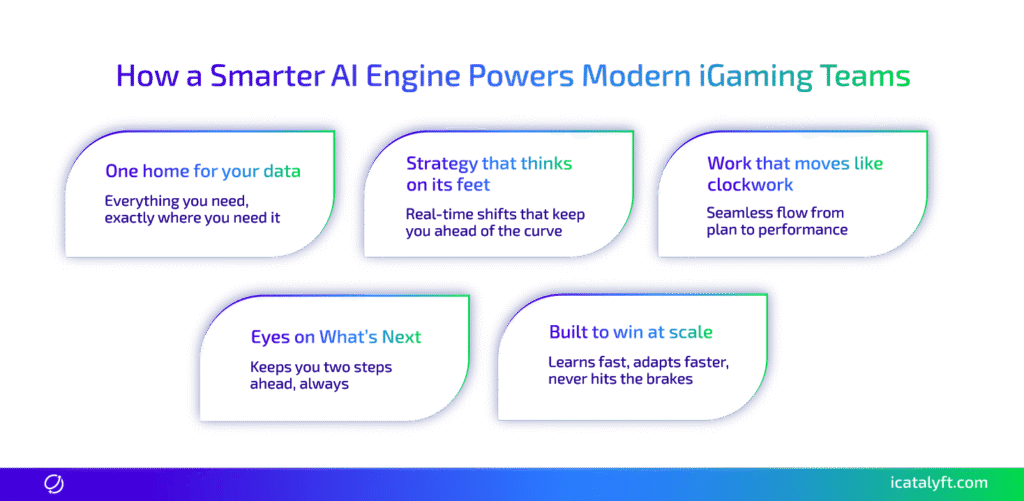
Are you looking to move beyond clunky and disconnected tools? It’s time to introduce a smarter approach to AI-powered automation.
You shouldn’t just keep on adding more tools to your stack. The AI framework should be centered around a centralized system that integrates everything from content creation to real-time reporting. It’s all about connecting data and optimizing strategy as you go.
Here’s how it works:
- Data centralization: Everything from campaign performance to customer behavior in one place.
- Adaptive strategy: AI adjusts and fine-tunes based on real-time insights, ensuring campaigns are always aligned with goals.
- Seamless workflow: It connects marketing tasks across tools, creating a unified system that learns and improves.
How Centralized Data and AI Drive Smarter Marketing
Ever felt like you’re working with one hand tied behind your back? That’s what it feels like when your data is scattered across different platforms.
At the heart of any effective AI-powered marketing system is centralized data. When you combine your campaign metrics, CRM data, product insights, and performance stats into one system, you see the full picture. You’ll know what’s working and what’s not, all in real time.
With everything in one spot, you can finally stop managing multiple systems and dealing with scattered data. Streamlining your marketing means smoother operations leading to faster and smarter decisions.
Using Predictive Analytics to Stay Ahead
Predictive analytics lets you spot trends before they happen. They provide you a head start on optimizing campaigns. You can adjust strategies early and prevent underperformance by analyzing your data carefully.
Instead of relying on guesswork, you make decisions backed by data. With the right tools, you can stay ahead of the game and adjust faster than the competition.
Using AI to Track Competitors and Market Trends
Did you ever stop and wonder how some brands seem to be one step ahead? You need to take a step back and smartly analyze what’s happening around you. With the right tools, you can track your competitors’ strategies and spot market shifts in real time.
This kind of insight gives you the edge you need to stay ahead.If you want to stay ahead of your competition, you need to act before they even see it coming.
Take this as an example. A game provider in Africa used AI to track competitors’ game releases and player preferences. They identified a gap in the market for a specific game genre and launched ahead of competitors and captured early player engagement. This gave them a first-mover advantage and a strong position in the region.
Aligning Sales & Marketing with AI-Driven Insights
Did you ever feel like sales and marketing are chasing different targets? A robust AI powered automation can help you fix that. It connects live sales data with marketing performance, so both teams see the same picture. The teams will know what’s converting and why.
Marketing builds campaigns based on what buyers actually respond to. Sales sees which messages and channels are driving real action. With shared visibility, both teams can adjust in real time and double down on what works. That alignment moves numbers.
Smart AI Usage for Personalization and Compliance
You can’t just shoot arrows in the dark and hope they hit the target. In B2B iGaming, you’re speaking to decision-makers. They are the people who know exactly what they want. Personalization is powerful, but it has to be precise and respectful. You need to be aware of privacy rules like GDPR at every step.
AI helps you strike that balance. That means pulling insights from compliant data sources, adjusting messaging based on consent, and making sure user preferences guide every step. You get relevance without crossing the line. And in regulated markets, that’s the only way to win long-term.
Guide for Newcomers and Early Adopters
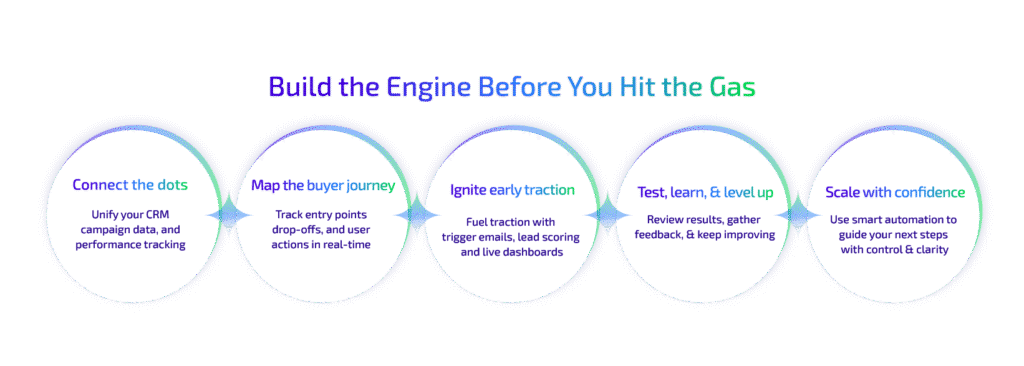
Just stepping into marketing automation? Or maybe you’ve already added a few tools, but things still feel messy? You’re not alone. Most B2B iGaming brands are figuring it out as they go.
Here’s a simple path to build a system that actually works.
- Get it in shape. Connect your CRM, campaigns, and performance tracking into one view. Without that, AI is just working in the dark.
- Know where your buyers come in, where they drop off, and what keeps them moving forward.
- No need to go big on day one. Begin with small wins like triggered emails, lead scoring, or a live dashboard.
- Use it to personalize your messages, spot early signs of campaign fatigue, or shift budget before performance dips.
- The best systems don’t stay static. Check your results, listen to your sales team, and keep evolving.
Getting Started with AI for Teams New to Automation
If you’re new to automation, start with centralizing your content operations. Begin with small steps like automating CRM flows or planning campaigns ahead of time. These simple actions will give you quick wins.
Once you’ve got that down, try basic AI tools for campaign optimization. Test how they improve your messaging. The key is to learn from the data and adjust your approach as you go. AI doesn’t need to be complicated. You need to start subtle and keep refining the approach as you grow.
Expanding AI’s Role Across Your Marketing Strategy
If you’re already using AI automation in B2B iGaming marketing, it’s time to scale up. Connect your analytics to your workflows and start scoring leads based on engagement. Look at the full journey, not just clicks, so your sales team focuses on leads that matter.
Use predictive analytics to stay ahead. AI can show you what your audience will want before they do. It helps you plan your next move, whether that’s content, campaigns, or strategy.
AI can also guide content distribution. It’ll tell you the best times to post, which channels to focus on, and which influencers to work with. The goal is to make smarter decisions quickly, without second-guessing yourself.
The Bottom Line
Are you pushing AI to its full potential in your marketing strategy? Let smart automations handle the grind and give your team co-pilots that equip them to dream bigger.
- Build a connected system where data, campaigns, and performance move together
- Let automation handle the heavy lifting so your strategy can move faster
- Act on insights in real time before opportunities slip through
- Make personalization feel timely and relevant, not templated
- Free up your team to focus on work that actually drives growth
If you’re ready to make this your everyday reality, drop us a line at iCatalyft. We’ll talk through your goals and sketch a roadmap for marketing automation that runs like a Swiss watch.
FAQs: AI Powered Automation in B2B iGaming Marketing
How does AI-powered automation connect sales, marketing, and CRM in iGaming?
AI-powered systems align account data, campaign delivery, and CRM activity under one roof. Sales and marketing work with shared insights, synced triggers, and faster pipeline movement.
How can AI-powered automation streamline game launches from research to go to market?
Smart workflows automate research, localization, segmentation, and rollout. Game providers reduce manual coordination and launch faster with content and targeting tailored for each region.
How do predictive automation systems improve iGaming campaign performance?
Forecasting models analyze behavioral trends, surface buying signals, and predict conversion drop-offs. Teams optimize strategy before issues impact pipeline or spend.
How does AI-powered automation reduce campaign waste in B2B iGaming?
Automation flags overspend, automates test cycles, and eliminates redundant tasks. Marketing ops stay lean and focused on what drives qualified engagement.
What ROI can B2B iGaming teams expect from AI-powered automation?
AI-powered automation shortens sales cycles, increases qualified lead conversion, and cuts time spent on manual tasks. Teams achieve higher output with lower operational cost.
